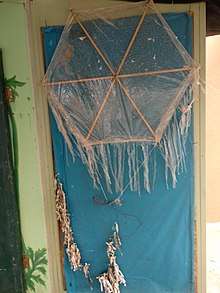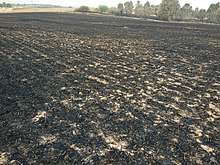Incendiary kite
An Incendiary kite[1](also Firebomb kite,[2] flaming kite,[3] Fire Kite[4]) is a kite with a bomb, incendiary device, or Molotov cocktail attached.

Historical use
Kites were first used in warfare by the Chinese.[5][6] During the Song dynasty the Fire Crow, a kite carrying incendiary powder, a fuse, and a burning stick of incense was developed as a weapon.[7] Walter de Milemete's 1326 De nobilitatibus, sapientiis, et prudentiis regum treatise depicts a group of knights flying a kite laden with a black-powder-filled firebomb over the wall of a city.[8] According to Samguk Sagi, in 647 Kim Yu-sin, a Korean general of Silla rallied his troops to defeat rebels by using flaming kites which also scared the enemy.[9] In the 17th century, the forces of Thai king Phetracha tied gunpowder barrels to kites used for airborne assault.[6]
Gaza Strip use

During the 2018 Gaza border protests Palestinians from the Gaza Strip have flown fire bomb kites over the Israel–Gaza barrier, setting fires on the Israeli side of the border,[10][11][12][13] Since the beginning of May 2018,[14] longer range helium filled incendiary balloons, devised from party balloons and condoms, have been used alongside the kites.[15][16][17] In one instance, a falcon outfitted with a harness with flaming material at the end was utilized as well.[18]
As of 10 July 2018, incendiary kites and balloons have started 678 fires in Israel, destroying 2,260 acres of woodland and 1,500 acres of agricultural fields as well as causing additional damage to open fields.[19]
Aerial incendiary use and war crimes
The use of fire bomb kites and balloons from Gaza is arguably a war crime under International Humanitarian Law. According to the International Committee of the Red Cross Customary International Law study Rule 84. The Protection of Civilians and Civilian Objects from the Effects of Incendiary Weapons. If incendiary weapons are used, particular care must be taken to avoid, and in any event to minimize, incidental loss of civilian life, injury to civilians and damage to civilian objects [20].
The prohibition can be sourced to Protocol Additional to the Geneva Conventions of 12 August 1949, and relating to the Protection of Victims of International Armed Conflicts (Protocol I), 8 June 1977. Article 51 Any use of incendiary weapons in the course of hostilities must, however, comply with the IHL prohibition on indiscriminate attacks, in particular the prohibition on attacks which employ a method or means of combat which cannot be directed at a specific military objective, or the effects of which cannot be limited as required under IHL, as well as the specific prohibition on area bombardment, the prohibition on disproportionate attacks, and the requirement to take all feasible precautions in the choice of means and methods of attack with a view to avoiding, and in any event to minimizing, incidental harm to civilians[21].
See also
References
- Incendiary kite from Gaza causes massive fire in Be'eri Forest, YNET, 2 May 2018
- Army warns Gazans against flying firebomb kites into Israel, Times of Israel, 4 May 2018
- Flaming Kites From Gaza Thwarted by Winds, New York Times, 4 May 2018
- https://www.timesofisrael.com/palestinian-fire-kites-destroy-much-of-nature-reserve-along-gaza-border/
- Military Aircraft, Origins to 1918: An Illustrated History of Their Impact, Justin D. Murphy, page 2
- The Strange and Violent History of Kites, Haaretz, Noa Manheim, 28 June 2018
- China Reconstructs, Volume 33, 1984
- Taking Flight: Inventing the Aerial Age, from Antiquity Through the First World War, Richard Hallion, pages 9-10
- History of Science in Korea, Sang-un Chŏn, page 181
- Gazans Fly Firebombs Tied to Kites Into Israel, Sparking Several Blazes, Haaretz, 16 April 2018
- Gazans use kites to set fire to fields, forests in Israel, JNS, 17 April 2018
- Flaming kite from Gaza sets Israeli warehouse ablaze, Times of Israel, 21 April 2018
- Continuing kite threat puts Israeli farmers on edge, YNET, 24 April 2018
- Kite terror continues to strike Gaza border communities, 8 May 2018, YNET
- Beyond kites: ‘Fire balloons’ increasingly used to set southern Israel ablaze, Times of Israel, 4 June 2018
- Israel announces Gaza sanctions in response to cross-border blazes, Reuters, 9 July 2018
- Gaza rocket barrage triggers Israeli air strikes, BBC, 20 June 2018
- Gaza’s Latest Weapon? Arson Bird Found Near Border With Israel, Bloomberg, Alisa Odenheimer, 17 July 2018
- Kite, balloon terrorism continues scorching Israel's land, YNET, Matan Tzuri, 10 July 2018
- "Customary IHL - Rule 84. The Protection of Civilians and Civilian Objects from the Effects of Incendiary Weapons". ihl-databases.icrc.org. Retrieved 2019-06-28.
- "Treaties, States parties, and Commentaries - Additional Protocol (I) to the Geneva Conventions, 1977 - 51 - Protection of the civilian population". ihl-databases.icrc.org. Retrieved 2019-06-28.